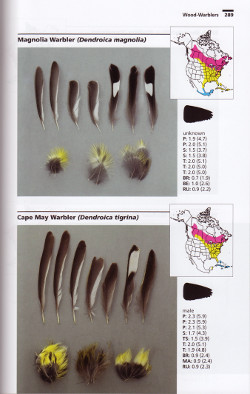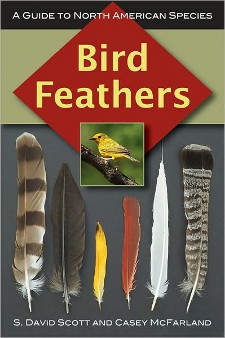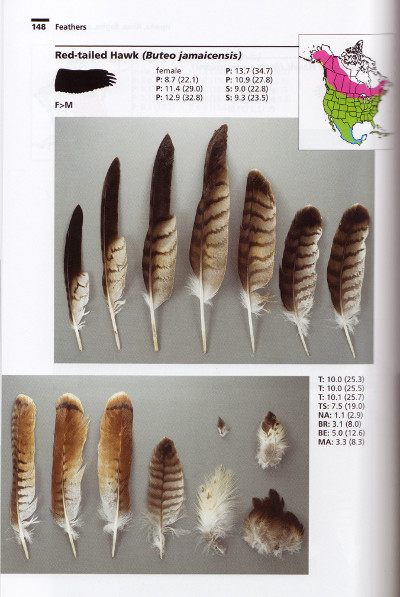Reviewed by Grant McCreary on February 24th, 2011.
While on a field trip recently at a water treatment facility someone found a bird wing. It wasn’t immediately obvious to me what species had been the unlucky victim, but another birder identified it as belonging to a Wilson’s Snipe. I had no reason to doubt the identification, as I had probably seen more snipe that day than I had in my entire life beforehand. And then there’s the fact that the identifying birder was none other than David Sibley.
You may never stumble across a complete wing, but most people find bird feathers from time to time. As a birder, it’s impossible not to wonder what species they may have belonged to. But it’s usually not easy to figure out; traditional field guides are great for entire birds, but not so much for individual feathers. In order to have a shot at identification, you can either make sure to always bird with Sibley, or you can use Bird Feathers: A Guide to North American Species.
Bird Feathers presents representative feathers from 397 North American birds. For each species, 6-28 feathers (average of 10-12) are laid out next to each other and photographed against a neutral background. Multiple primaries, secondaries, and tail feathers are included for most, along with a sampling of body feathers. A caption identifies the kind of feather and gives the length in both inches and centimeters.
The accounts also indicate what kind of wing type the bird has (as defined in the introduction) and whether the feathers shown came from a male, female, juvenile, or if this is unknown. Color range maps show permanent, summer, winter, and migration ranges.
Bird topography illustrations and a list of abbreviations used are included on the inside of the covers. The inside edges are also marked like a ruler, with inches on the inside-front cover and centimeters on the back, facilitating the measurement of found feathers. These additions are very handy and most appreciated.
I happened to have this guide in my car during the aforementioned field trip when the wing was found. I took the opportunity to compare the actual feathers with what is shown in the book, and they were clearly a match. Even if we didn’t have the correct identification to begin with, taking the authors’ suggestion of considering where it was found would have led us to check it against a snipe relatively early in the identification process.
Bird Feathers is obviously valuable as a reference, but I have found it surprisingly interesting to simply flip through. I suppose this should be obvious, but looking at individual feathers can be a radically different experience than looking at the full bird. For instance, I don’t think anyone could imagine that the feathers shown here could belong to something as gorgeous as a Painted Bunting. Conversely, I found the individual Pine Siskin feathers much more striking than the bird as a whole.
 It’s also fun and educational to see how well-known field marks are formed by the individual feathers. For instance, the secondaries of ducks with iridescent speculums are iridescent on only one vane of the feather. The vane that will be covered by the neighboring feather is “normal”. Presumably, iridescence is more costly to produce. Also, it’s not immediately apparent that these Magnolia Warbler tail feathers would produce the bird’s classic “dipped in ink” pattern. In the field the base of the tail appears white. However, the white portion is actually at the mid-way point of the feather, and the base is dark. But this dark portion is hidden by the undertail coverts. I never realized how much of a tail is covered by the coverts.
It’s also fun and educational to see how well-known field marks are formed by the individual feathers. For instance, the secondaries of ducks with iridescent speculums are iridescent on only one vane of the feather. The vane that will be covered by the neighboring feather is “normal”. Presumably, iridescence is more costly to produce. Also, it’s not immediately apparent that these Magnolia Warbler tail feathers would produce the bird’s classic “dipped in ink” pattern. In the field the base of the tail appears white. However, the white portion is actually at the mid-way point of the feather, and the base is dark. But this dark portion is hidden by the undertail coverts. I never realized how much of a tail is covered by the coverts.
You will also learn a great deal from the introduction. The first part covers feather origins, types, and how they contribute to flight. A chapter on flight feather identification describes each of the wing and tail types and their respective feathers. Numerous photos accompany the text, including very helpful shots of each wing type as a whole, along with all of the individual flight feathers laid out side by side. This 63-page introduction is very helpful and instructive, and should not be skipped.
Adult birders aren’t the only ones who can learn from Bird Feathers. It can also lead to teaching opportunities for kids. Examining feathers can facilitate discussions about flight and all the other concepts covered in the book’s introduction. This includes conservation. When the child asks why they can’t keep the feather, you can tell them it was made illegal to possess feathers in order to protect birds from the plume harvest that almost resulted in the extinction of our herons and egrets.
Obviously, at fewer than 400 species, Scott and McFarland have not included every bird in the United States and Canada. Nor do they show every type of feather for each bird that is included. But that would go beyond the scope of this book as an introduction and field guide to bird feathers. The birds here are those of which you’re most likely to find a feather.
Recommendation
As a reference, Bird Feathers will be useful to anyone who spends significant time outdoors. But for birders, it’s even more valuable for the insight it provides into birds’ lives, form, and appearance.
Disclosure: I get a small commission for purchases made through links in this post.
Disclosure: The item reviewed here was a complementary review copy provided by the publisher. But the opinion expressed here is my own, it has not been influenced in any way.






Quality review of what appears a quality book. If only such a book existed for ‘Northern Europe’. I’d have been typing my plastic’s number right now 😉
[…] Bird Feathers Identification | credit image source : www.birderslibrary.com […]
I really love these charts , thank you
I have found some feathers i cannot identify. Could you please help ? Thanks
Jasen: try this online resource – https://www.fws.gov/lab/featheratlas/idfeather.php
[…] Bird feathers: A guide to North American Species […]
Thanks for this review! I have quite a collection from years of looking, travel and having a bird crazy father! Can’t wait to get my copy!
AKA: Anisa Bird Shaman Woman